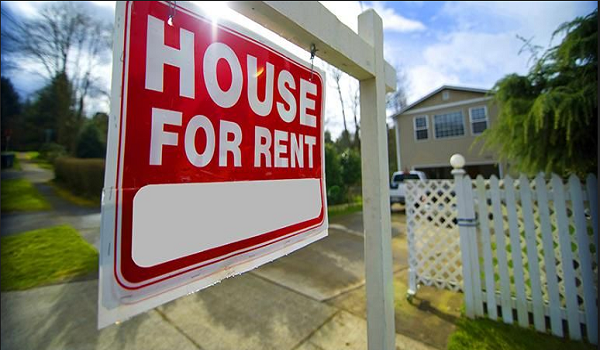Tenants are still competing in an affordable housing market, amid slowing rent hike
Every day, Justine Goodchild pulls up the same rotation of websites: realtor.ca, PadMapper, anywhere she might find a new rental where she, her partner and their dog could live.
On a good day, there are a few new listings that fit what they’ve been looking for on-and-off for two years — under $4,000, a bit bigger than the two-bedroom they’ve leased in Toronto’s Beach neighbourhood since 2017, and ideally with a bit of yard space for their Boxer pup, Reggie.
But even if a listing isn’t snapped up faster than they can visit, their efforts to ink a new lease have been repeatedly foiled by other applicants offering more than the listed price, leaving them stuck in a place they’ve outgrown. And while the Toronto rental market is showing signs of simmering — with average costs up more modestly year-over-year towards the end of 2023 — Goodchild doubts it’ll make a difference for anyone looking, given the continued affordability squeeze.
“I don’t feel like there is a reality that exists where you’re going to feel comfortable with the amount of money you’re paying for a place to live in Toronto,” Goodchild said.
Experts and analysts agree this will likely be the 2024 reality: while rent inflation has slowed in recent months, prices are still expected to rise by year’s end due to factors ranging from an undersupplied market to more would-be buyers priced out of ownership.
While that rise is expected to be more moderate than in recent years, any cost increase comes atop record-breaking post-pandemic rent levels — with even bachelor units pricing out some midincome earners, and rent pressure extending well beyond the city core, into the suburbs and beyond.
“Our assumptions for rents moving into 2024 is we’ll see rent growth in Toronto a little more consistent than the five-to-10-year average,” said Shaun Hildebrand, president of research firm Urbanation — forecasting a four to five per cent rise by year’s end. “But these rates of growth are coming off of already record high levels. The market isn’t going to become more affordable.”
The rising cost of the city’s smallest options
At the start of last year, the average listing price for a bachelor apartment in Toronto was $1,892 per month, according to rentals.ca network data analyzed by Urbanation. That meant a person needed to earn at least $76,000 per year to comfortably afford the lease.
By September, the average had risen to $2,107, requiring at least $85,000. And even after prices cooled somewhat in December, the $2,048 average still required an $82,000 income. If bachelor unit prices rise at a similar rate to Hildebrand’s overall market prediction of four to five per cent, that would mean a cost of $2,150 by year’s end and a required income of at least $86,000.
The average studio rents are just one sign of waning affordability. A separate Urbanation report recently found that, while a quarter of GTA condo rentals in 2022 were listed for less than $2,250, that had thinned to six per cent in 2023.
“Renters end up squeezed at the bottom,” said Hildebrand.
Dania Majid, a lawyer with the Advocacy Centre for Tenants Ontario, says this kind of income requirement for a studio unit has “huge ramifications.” She said it risks cutting down the available workforce for jobs in the service industry, retail and the arts, among examples, noting that even in higher-earning industries, the pressure was palpable.
“To be able to afford something on even a decent salary is just becoming more and more difficult,” Majid said.
Wanted: more roommates to split the bills
As rents climb, more tenants have turned to the tried-and-true method of bringing their bills down — getting a roommate or two. But that’s also becoming harder to affordably access, with last year’s data showing the average listing for a unit split between roomies ranged from a low of $1,288 in June to a high of $1,388 per person in April. That means, at the lowest point, even juggling questions about whose dishes are in the sink was an option affordable only to those earning at least $52,000.
After the year’s fluctuation, the average roommate listing price ended at $1,311 in December 2023, up about eight per cent from $1,210 in December 2022.
The seasonal change seen throughout the year is unsurprising, says Majid, noting prices seemed to pick up during times of fierce competition, such as when post-secondary students are searching for leases for the year.
She expects that the trend of roommate living will only continue in 2024, and into later phases of tenants’ lives. “It’s not just something you’re going to do when you first venture into the rental market,” Majid predicted.
David Amborski, a Toronto Metropolitan University housing expert, believes developers are taking notice — citing proposals he’s see lately for purpose-built co-living spaces, or “micro-units” under 300 square feet as an alternative to roommate living. But while he can foresee these options becoming “more common,” he does not expect them to become a dominant model.
Renting for a family: the erratic price tags of larger units
Tracking the cost of three-bedroom rentals in Toronto produces a chart like a yo-yo — beginning at an average cost of $3,636 in January and spiking up and down before ending the year at an average of $3,843. These units come at a premium: even at the lowest point, the average unit required an income of at least $146,000, rising as high as $159,000.
The erratic monthly price changes are a consequence of limited supply and a smaller sample size, analysts say. “There aren’t that many larger units in general,” Hildebrand said, noting condos today tended to skew towards investors looking for smaller spaces to maximize income potential. Purpose-built rental units tended to be larger, he said, but those are a much smaller slice of the market.
And the average unit has shrunk: 727 square feet at the end of 2023, 793 square feet a year earlier, and 806 square feet five years prior, Hildebrand said. “It’s largely a response to affordability.”
The consequence was “a very family unfriendly city,” Majid noted. People not only questioned if they could afford the space to have kids, she said, but also struggled if they hoped to care for an aging parent within their household in a multi-generational setup.
Amborski, who cautioned that “luxury” rentals could skew the data for larger units, does not expect much change to supply in 2024. While some cities around Toronto have seen more interest in single-family home rentals, he noted that within the city itself, that’s unlikely to take hold in a bigger way given rents were less likely to be able to offset higher property costs.
Relief in the suburbs? Not so fast.
Thinking about fleeing the city core in search of relief from soaring rents? It wasn’t an ideal strategy in 2023, as areas such as North York and Scarborough saw costs rise sharply, and analysts expect rental pressure to continue throughout the suburbs in 2024. Across all unit types, the average North York rental in January 2023 cost $2,230, affordable to a household earning at least $90,000 annually. By December, that rose to $2,631, or a $106,000 income.
In Scarborough, where prospective tenants started the year facing an average listing cost of $2,143 (requiring a minimum income of $86,000 to make it affordable), that rose to $2,470 by the time the year drew to a close, meaning they would now need to earn at least $99,000 per year.
Willing to leave the city entirely? Rent pressures followed throughout GTA communities such as Brampton and Mississauga, too. For 2024, Hildebrand expects above-average rental inflation in the suburbs to eclipse the rate of rent growth seen in Toronto’s core — citing an even more constricted supply of rentals, hardly any new rental development in certain areas, and continued demand, including from new immigrants more likely to settle in the suburbs and Torontonians fleeing the city in search of affordability.
“When you have that influx of demand against a very limited supply of rentals, it’s going to continue to put upward pressure on rents,” he said.
Majid said she’d seen a rising number of people leaving the province altogether, finding even cities near Toronto had just gotten too pricey.
“Affordability is still the primary concern, in that everything is just utterly unaffordable.”
This article was reported by The Star













